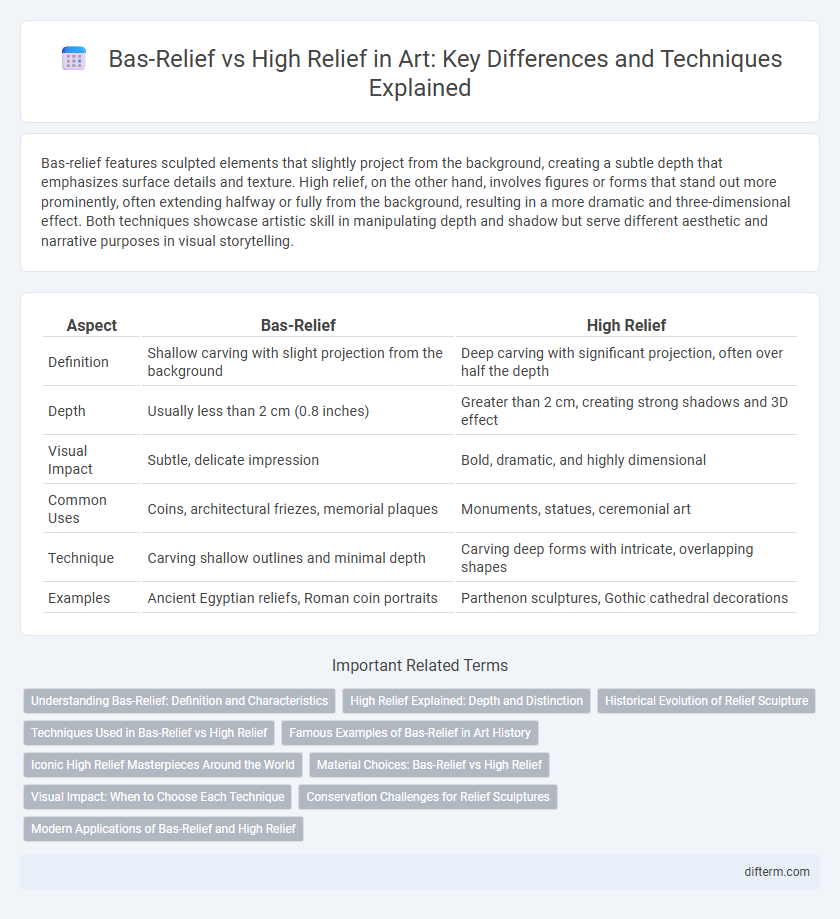Bas-relief features sculpted elements that slightly project from the background, creating a subtle depth that emphasizes surface details and texture. High relief, on the other hand, involves figures or forms that stand out more prominently, often extending halfway or fully from the background, resulting in a more dramatic and three-dimensional effect. Both techniques showcase artistic skill in manipulating depth and shadow but serve different aesthetic and narrative purposes in visual storytelling.
Table of Comparison
| Aspect | Bas-Relief | High Relief |
|---|---|---|
| Definition | Shallow carving with slight projection from the background | Deep carving with significant projection, often over half the depth |
| Depth | Usually less than 2 cm (0.8 inches) | Greater than 2 cm, creating strong shadows and 3D effect |
| Visual Impact | Subtle, delicate impression | Bold, dramatic, and highly dimensional |
| Common Uses | Coins, architectural friezes, memorial plaques | Monuments, statues, ceremonial art |
| Technique | Carving shallow outlines and minimal depth | Carving deep forms with intricate, overlapping shapes |
| Examples | Ancient Egyptian reliefs, Roman coin portraits | Parthenon sculptures, Gothic cathedral decorations |
Understanding Bas-Relief: Definition and Characteristics
Bas-relief, also known as low relief, is a sculptural technique where the figures are slightly raised from the background surface, creating a subtle depth that remains closely attached to the base. This method is characterized by shallow carving, allowing light to cast gentle shadows that enhance the intricate details without significant protrusion. Unlike high relief, bas-relief maintains a delicate balance between two-dimensional and three-dimensional forms, often used in coins, architectural decorations, and narrative panels.
High Relief Explained: Depth and Distinction
High relief, or alto-relievo, features sculptures that project significantly from the background, often by more than half their depth, creating strong shadows and a pronounced three-dimensional effect. This technique allows for intricate details and dynamic compositions, enhancing the perception of depth and realism. Unlike bas-relief, where figures are shallowly carved, high relief provides greater visual distinction, making it a preferred choice for monumental art and architectural decoration.
Historical Evolution of Relief Sculpture
Bas-relief and high relief sculpture have evolved significantly from ancient civilizations such as Mesopotamia and Egypt, where bas-relief depicted narratives on temple walls with shallow depth for durability and visibility. During the Renaissance, high relief gained prominence for its dramatic use of deep carving to create pronounced shadows and lifelike figures, enhancing emotional impact and realism. This historical evolution reflects shifts in artistic techniques and cultural values, emphasizing either subtle storytelling or dynamic visual experiences in relief art.
Techniques Used in Bas-Relief vs High Relief
Bas-relief technique involves shallow carving where figures slightly project from a flat background, emphasizing subtle depth and intricate surface detail. High relief employs deeper carving, creating pronounced three-dimensional forms that extend significantly from the background, resulting in dramatic shadows and strong visual impact. Both techniques require mastery of chiseling tools, with bas-relief focusing on precision and fine lines, while high relief demands careful sculpting to maintain structural integrity and dynamic volume.
Famous Examples of Bas-Relief in Art History
Famous examples of bas-relief in art history include the intricate panels of the Parthenon frieze, showcasing classical Greek mythology with shallow depth and delicate detail. The ancient Mesopotamian Stele of Hammurabi features bas-relief carvings that combine text and imagery to depict the law's divine origin. The Angkor Wat temple complex in Cambodia also displays extensive bas-relief scenes illustrating Hindu epics with remarkable narrative clarity and stylistic precision.
Iconic High Relief Masterpieces Around the World
Iconic high relief masterpieces such as the Parthenon Marbles in Greece and the Trajan's Column in Rome showcase dramatic depth and intricate detail, with figures projecting significantly from the background. Unlike bas-relief, which maintains a shallow depth and subtle forms seen in Egyptian temple carvings, high relief amplifies three-dimensionality, creating dynamic visual narratives that engage viewers more intensely. These masterpieces highlight the technical skill and artistic innovation of ancient sculptors in conveying movement and emotion through exaggerated depth and textured surfaces.
Material Choices: Bas-Relief vs High Relief
Bas-reliefs often utilize softer materials like plaster, clay, and wood due to their shallow depth, allowing for intricate details without structural strain. High reliefs require sturdier materials such as marble, bronze, or stone to support their pronounced projections and three-dimensional forms. Material selection directly influences the durability and visual impact of the sculpture, with high reliefs demanding substances capable of bearing greater weight and exposure.
Visual Impact: When to Choose Each Technique
Bas-relief offers subtle depth and shadowing, making it ideal for intricate narrative scenes where fine detail is paramount without overwhelming the viewer. High relief creates a dramatic visual impact through pronounced three-dimensionality, perfect for focal points that require emphasis and bold textures. Choosing between bas-relief and high relief depends on the desired intensity of visual engagement and the spatial context of the artwork.
Conservation Challenges for Relief Sculptures
Bas-relief and high relief sculptures present distinct conservation challenges due to their varying depths and exposure levels; bas-reliefs, with shallow carvings often integrated into architectural elements, are vulnerable to surface erosion and environmental pollutants. High reliefs extend more prominently from their backgrounds, increasing the risk of physical damage from weathering, biological growth, and mechanical impact. Effective preservation requires tailored approaches such as controlled environments, careful cleaning, and protective coatings to address the specific vulnerabilities of each relief type.
Modern Applications of Bas-Relief and High Relief
Modern applications of bas-relief and high relief in art extend to architectural facades, interior design, and public sculptures, where depth and texture create engaging visual narratives. Bas-relief is favored for its subtlety and integration in panels and decorative friezes, while high relief offers dramatic shadow play ideal for museums and outdoor monuments. Advances in digital sculpting and 3D printing have expanded possibilities for intricate, tactile details in both relief styles, enhancing their presence in contemporary urban landscapes.
bas-relief vs high relief Infographic

 difterm.com
difterm.com